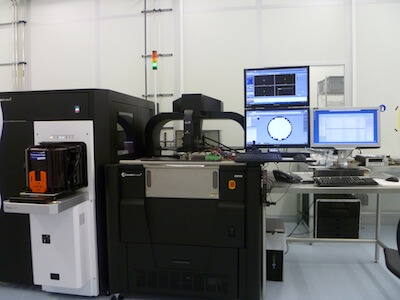My visit to imec to meet with the Cascade Micorotech and imec 3D Test collaboration team included a tour of the 3D test lab to see the CM300 in action, so we suited up for Class 1000 cleanroom and stepped inside. Generally we would have had to prep for class 100 or higher for the test environment, but thanks to nifty new FOUPs that have a class 1 microenvironment to protect the wafers, we at least didn’t need the face masks. (I was grateful for that!)
Imec researcher Bart De Wachter explained all the different parts of the tool and their purpose and put the tool through its paces. While the CM300 is designed for lab engineering and development, it is also modular and scalable for efficiency and high throughput. Two probe stations can share each material handling and/or thermal unit, or a probe station can stand alone as a semi-automated tool that loads manually. De Wachter explained that this means the test wafer is loaded manually, but the probing is done automatically. The chuck has also been retrofitted to accommodate a thin wafer mounted on a dicing frame. There is a thermal chuck that can be heated up or cooled down to do thermal test cycling, and there are auxiliary sites for probe card cleaning contacts. One site carried a cleaning substrate made of tungsten carbide for cleaning the Cascade Microtech Rocking Beam Interposer contactors, and the other equipped with adhesive for cleaning conventional cantilever probes. Each probe card’s contacts are customized to each chip design, explained De Wachter. For this demo, it was configured for imec’s Wide I/O Vesuvius test vehicle. Erik Jan Marinissen previously explained that the Vesuvius contains a Wide I/O test vehicle developed by imec. Part of the test sequence involves pre-bond testing through the large-array fine-pitch micro-bumps. De Wachter detailed the demo: The CM300 was set up in “wide I/O configuration” as follows: The Cascade Microtech Wide IO Vesuvius probe card and Rocking Beam Interposer core with 300 contacts were hooked up to the PXI instrumentation by custom-made interface boards and cabling. PXI instrumentation used included two SMUs, a digital multi-meter and a switch matrix for measuring micro-bump-to-probe core daisy chain continuity. Both the probe station and instrumentation were controlled by a controller PC with USB-GPIB interface and LabVIEW software. The actual test: A wide IO Vesuvius wafer was loaded from the Front Opening Unified Pod (FOUP), pre-aligned in the loader and loaded onto the chuck. The final alignment of the wafer was executed through probe core tip height detection and core alignment; wafer height detection and alignment; camera synchronization and setting the wafer home position. Next, stepping over the sub-dies/dies/wafer was initiated: all four wide I/O channels per die were measured and wafer map binning commands executed. Realignment was done for accurate probing every five dies. Probe tip cleaning on a Tungsten Carbide substrate was executed every 19 dies. This video shows a segment of the test sequence: Wachter said that some other test sequences being performed around inline test include:
- Direct transfer of pre-bond software wafer maps to pick and place tools
- Automated data analysis report extraction
“I’ve been working with the CM300 probe station for about a year now. When looking at the number of experiments we have been able to do in this timeframe, the versatility of the tool really shines through and I believe this is one of the strongest points of the CM300,” said De Wachter. A brief summary of the work he’s done using this tool includes:
- Probing and testing standard thick 300mm (800µm) and 200mm (900µm) wafers
- Probing and testing with cantilever probe cards (regular and deep tips), vertical buckling beam- and MEMS based probe cards: Pyramid small pitch (40µm) high tip count (#300) and experimental crown-tip probe cards
- Probing and testing single die stacks on the auxiliary sites with buckling beam probe cards
- Fully unattended parametric testing (25 wafers non stop for several days without user interaction) with automated probe tip cleaning algorithms and wafer map binning
“I believe one of the keys to making this possible is the fact that almost every probe station parameter you can think of can be set individually and is available as a remote command which makes for a seamless integration of outboard controllers,” noted De Wachter. “Bottom line, I couldn’t be happier!”





















